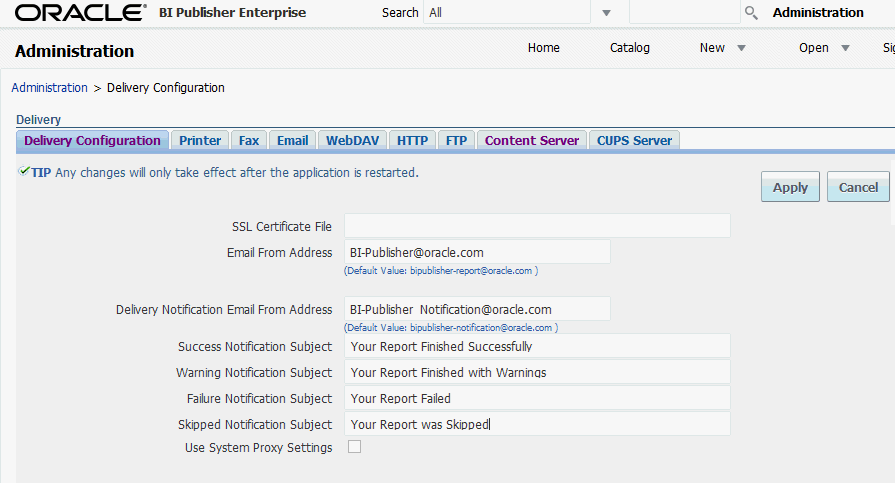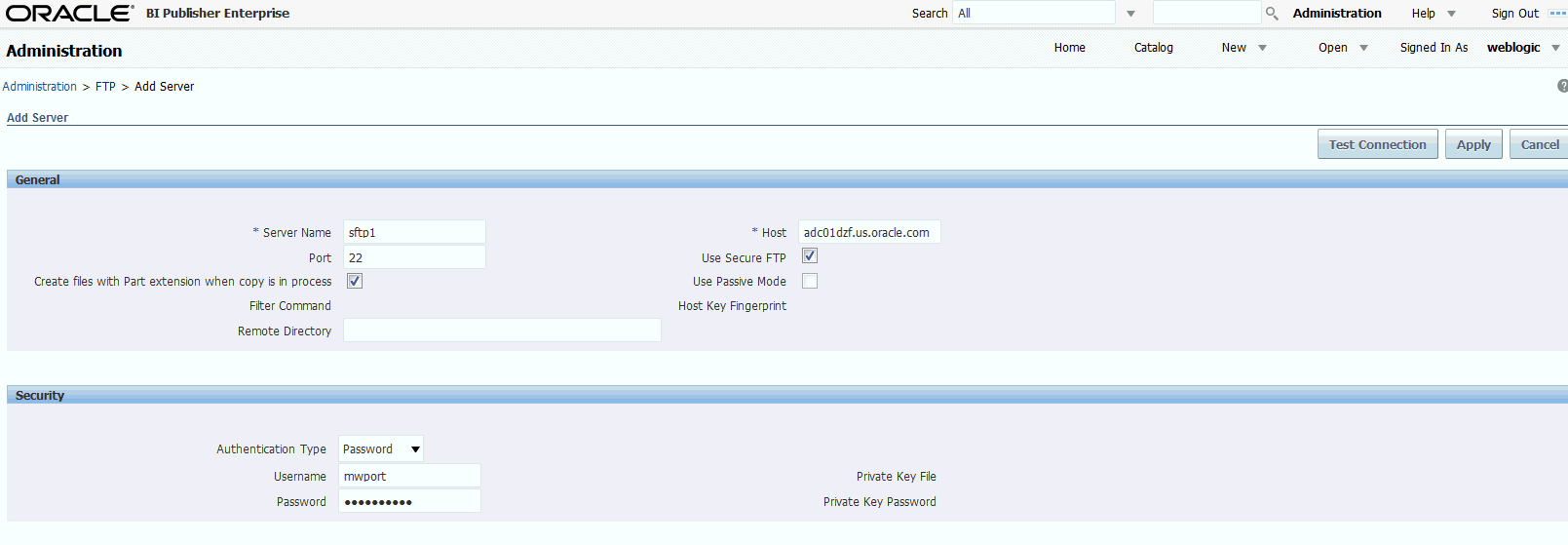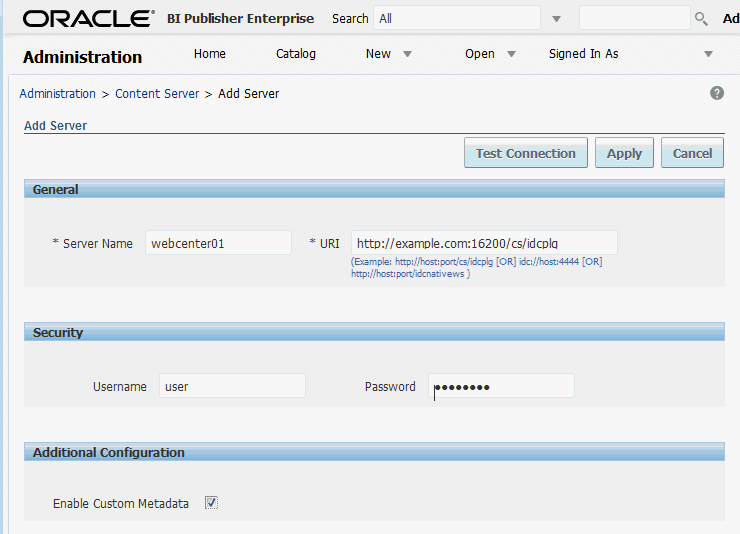10 Setting Up Delivery Destinations
It covers the following topics:
Configuring Delivery Options
Use the Delivery Configuration Options page to set general properties for e-mail deliveries and notifications from BI Publisher and for defining the SSL certificate file.
To configure delivery options:
Adding a Printer
Regardless of whether BI Publisher is running on Linux, Unix, or Windows, the printer destination can be any IPP server.
The IPP server can be the printer itself, which is the easiest option, but if the printer does not natively support IPP, you can set up a print server that does support IPP (such as CUPS) and connect BI Publisher to the print server and then the print server to the printer. In this print server scenario, the print server can run on any operating system.
To send fax from BI Publisher, you must set up Common Unix Printing Service (CUPS) and the fax4CUPS extension, to enable connection to your fax server from BI Publisher. The fax set up requires this plugin to the CUPS server on the operating system. Note that the Administration page makes the distinction between a fax and a printer server in the UI, so that users can pick one or the other or both at runtime. Even though the fax and printer server that the users see can both use a single CUPS server.
For information on setting up CUPS or Windows IPP print servers and how to connect network printers to them, refer to the CUPS or Windows IPP software vendor documentation.
Two types of security are supported: Basic and Digest.
About Printing PDF
PDF is a popular output format for business reports and is printable from viewer software such as Adobe Reader. However, some reports require printing directly from the report server. For example, paychecks and invoices are usually printed as scheduled batch jobs. Some newer printers with PostScript Level 3 compliant Raster Image Processing can natively support PDF documents, but there are still many printers in business use that only support PostScript Level 2 that cannot print PDF documents directly.
To print PDF documents directly from the BI Publisher server if your printer or print server does not support printing PDF, you have the following options:
-
Select one of BI Publisher's filters: PDF to PostScript or PDF to PCL.
-
Configure a custom, or third-party filter.
After completing all other required fields for the print server, you can schedule reports to print directly from the BI Publisher server to any printer in your system that supports PostScript Level 2.
Setting Up a Printer
You set up printers from the Administration page.
To set up a printer:
-
From the Admin page select Printer. Select Add Server.
-
Enter the following required fields:
-
Server Name — Enter a unique name. Example: Localprinter
-
URI — Enter the Uniform Resource Identifier for the printer.
Example:
ipp://myhost:631/printers/myprinterExample URI syntax for Windows IPP server:
http://ip-address/printers/name-printer/.printer
-
-
Enter a Filter (optional).
A filter enables you to call a conversion utility to convert the PDF generated by BI Publisher to a file format supported by your specific printer type. BI Publisher provides the following filters:
-
PDF to PostScript
BI Publisher includes a PDF to PostScript filter. This filter converts PDF to PostScript Level 2. Select PDF to PostScript from the list to use BI Publisher's predefined filter.
-
PDF to PCL
To convert PDF to PCL, select PDF to PCL. This automatically populates the Filter Command field.
BI Publisher supports the PDF to PCL conversion only for font selection requirements for check printing. For generic printing requirements, use the PDF to PostScript filter.
You can embed PCL commands into RTF templates to invoke the PCL commands at a specific position on the PCL page; for example, to use a font installed on the printer for routing and account numbers on a check. For more information, see Embedding PCL Commands for Check Printing in Report Designer's Guide for Oracle Business Intelligence Publisher.
You can also call a custom filter using operating system commands.
About Custom Filters
To specify a custom filter, pass the native OS command string with the two placeholders for the input and output filename, {infile} and {outfile}.
This is useful especially if you are trying to call IPP printers directly or IPP printers on Microsoft Internet Information Service (IIS). Unlike CUPS, those print servers do not translate the print file to a format the printer can understand, therefore only limited document formats are supported. With the filter functionality, you can call any of the native OS commands to transform the document to the format that the target printer can understand.
For example, to transform a PDF document to a PostScript format, enter the following PDF to PS command in the Filterfield:
pdftops {infile} {outfile}
To call an HP LaserJet printer setup on a Microsoft IIS from Linux, you can set Ghostscript as a filter to transform the PDF document into the format that the HP LaserJet can understand. To do this, enter the following Ghostscript command in the Filter field:
gs -q -dNOPAUSE -dBATCH -sDEVICE=laserjet -sOutputFile={outfile} {infile}For fax servers, you can use the filter to transform the file to Tag Image File Format (TIFF).
-
-
Optionally enter the following fields if appropriate:
-
Security fields — Username and Password, Authentication Type (None, Basic, Digest) and Encryption Type (None, SSL).
-
Proxy Server fields — Host, Port, User Name, Password, Authentication Type (None, Basic, Digest)
-
Adding a Fax Server
To send fax from BI Publisher, you must set up Common Unix Printing Service (CUPS) and the fax4CUPS extension, to enable fax transmissions from BI Publisher.
See the following resources for information about setting up CUPS and the fax4CUPS extension:
To set up fax delivery:
Adding an E-Mail Server
You add an e-mail server from the Administration page.
To add an e-mail server:
Adding a WebDAV Server
You add a WebDAV server from the Administration page.
To add a WebDAV server:
Adding an HTTP Server
You can register an application URL or postprocess HTTP URL as an HTTP server to send a notification request to after the report has completed.
The HTTP notification sent by BI Publisher posts a form data for Job ID, report URL and Job Status to the HTTP Server URL page.
To set up an HTTP notification to integrate with a third-party application, see Developer's Guide for Oracle Business Intelligence Publisher. To enable an HTTP notification for a scheduled report, see Configuring Notifications in User's Guide for Oracle Business Intelligence Publisher.
To add an HTTP server
- From the Administration page, select HTTP to display the list of servers that have been added. Select Add Server.
- Enter a name for the server, and enter the URL. When the report finishes processing, BI Publisher posts form data for Job ID, report URL and Job Status.
- Enter the Security information, if required. If your server is password protected, enter the Username and Password. Select the Authentication Type: None, Basic, or Digest; and Encryption Type: None or SSL.
- If the notification is to be sent through a proxy server, enter the fully qualified Host name, the Port, the Username and Password, and Authentication Type of the proxy server.
Adding an FTP Server
You can add an FTP server from the Administration page.
Note:
If the destination file name supplied to the BI Publisher scheduler contains non-ascii characters, BI Publisher will use UTF-8 encoding to specify the file name to the destination FTP server. Your FTP server must support UTF-8 encoding or the job delivery will fail with "Delivery Failed" error message.
To add an FTP server:
The following figure shows a sample SFTP delivery server setup:
SSH Options for SFTP
Secure File Transfer Protocol (SFTP) is based on the Secure Shell technology (SSH). Oracle BI Publisher supports the following SSH options for SFTP delivery.
| SSH Option | Supported Values |
|---|---|
| Cipher Suites |
Note: You can use aes192-ctr and aes256-ctr cipher suites only when BI Publisher is running on a JVM on which the Java Cryptography Extension (JCE) unlimited strength jurisdiction policy files are installed. |
| Key Exchange Method |
Note: You can use diffie-hellman-group-exchange-sha256 key exchange methods only when BI Publisher is running on a JVM on which the Java Cryptography Extension (JCE) unlimited strength jurisdiction policy files are installed. |
| Public Key Algorithm |
|
Adding a Content Server
You can deliver documents generated by BI Publisher to your Oracle WebContent Server.
BI Publisher's integration with the content server provides the following features:
-
At run time, the report consumer can tag the report with Security Group and Account metadata (if applicable) to ensure that the appropriate access rights are applied to the document when delivered.
See Adding Destinations in User's Guide for Oracle Business Intelligence Publisher.
-
For documents that require specific custom metadata fields (such as invoice number, customer name, order date), BI Publisher enables the report author to map the custom metadata fields defined in Content Profile Rule Sets to data fields in the data model.
See Adding Custom Metadata for Oracle WebCenter Content Server in Data Modeling Guide for Oracle Business Intelligence Publisher.
BI Publisher communicates with Oracle WebCenter Content Server using the Remote Intradoc Client (RIDC). The connection protocols therefore follow the standards required by the RIDC. The protocols supported are:
-
Intradoc: The Intradoc protocol communicates to the Content Server over the over the Intradoc socket port (typically 4444). This protocol requires a trusted connection between the client and Content Server and will not perform any password validation. Clients that use this protocol are expected to perform any required authentication themselves before making RIDC calls. The Intradoc communication can also be configured to run over SSL.
-
HTTP and HTTPS: The HTTP protocol connection requires valid user name and password authentication credentials for each request. You supply the credentials to use for requests in the BI Publisher Administration page.
-
JAX-WS: The JAX-WS protocol is supported only in Oracle WebCenter Content 11g with a properly configured Content Server instance and the RIDC client installed. JAX-WS is not supported outside this environment.
For more information about these protocols, see Using RIDC to Access Content Server in Developing with Oracle WebCenter Content.
To set up a connection to a content server as a delivery destination:
Adding a Common UNIX Printing System (CUPS) Server
You add CUPS servers from the Administration page.
See Adding a Printer for information about when you must configure CUPS.
To add a CUPS server:
- From the Administration page, select CUPS to display the list of servers that have been added.
- Select Add Server.
- Enter the Server Name and Host and Port for the CUPS server.
Adding a Cloud Server
BI Publisher can deliver reports to Oracle Document Cloud Services through a cloud server for enabling easy access and report sharing on the cloud.
- Login to BI Publisher with administrator privileges, navigate to Administration > Document Cloud Services.
- Click Add Server.
- In the Server Name field, type the name of the cloud server through which the BI Publisher must deliver the reports to Oracle Document Cloud Services.
- In the URI field, type the URI of the cloud server. For example, https://host.oraclecloud.com.
- In the Username and Password fields, provide the credentials for accessing the cloud server.
- Click Test Connection to ensure that the cloud server connection works.
- Click Apply to save.


